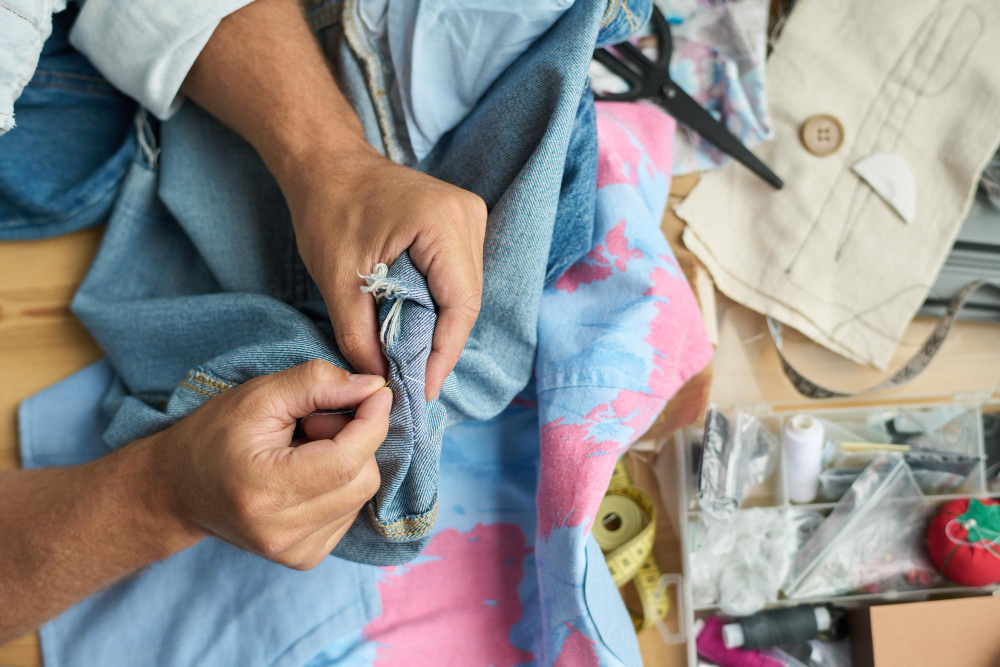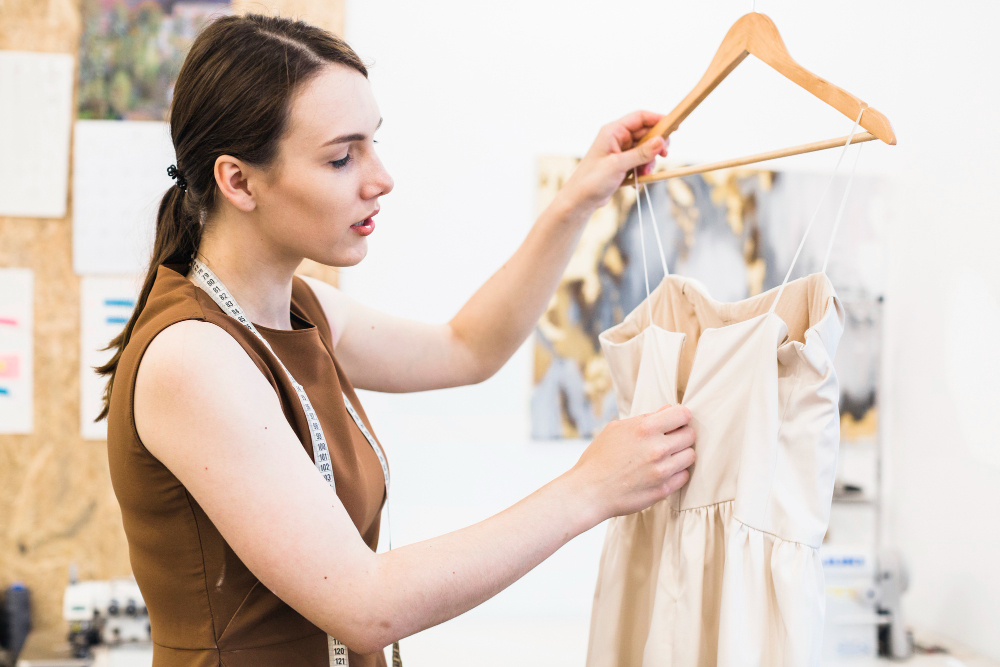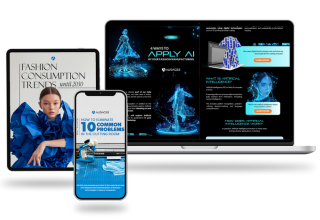Summary
- Upcycled clothing is a trend that’s gaining more attention every season. It’s a way to breathe new life into old garments, giving them a second chance.
- For designers wanting to make a mark in the fashion world, keeping an eye on this consumer demand is key.
- Experience the future of the fashion industry with Audaces360. Sign up for your free trial today!
Upcycling isn’t just about saving old clothes. It’s about creativity, sustainability, and making a positive impact.
Throughout the article, you’ll discover designing with second-life materials can open doors to new ideas. From experimenting with texture to rethinking silhouettes, there’s plenty of room for creative expression.
Let’s explore how upcycled clothing can improve your designs and help create a more sustainable future.
Enjoy the read and happy creating!
Sumário
Why is creating upcycled clothing important?
Fashion is one of the biggest contributors to waste. Every year, tons of clothes end up in landfills. Upcycled clothing helps reduce this waste by giving old garments a new life.
It uses existing materials, which means fewer resources are necessary. This lowers the overall environmental impact.
Moreover, upcycled clothing promotes creativity. Designers can experiment with old pieces to create something unique. It encourages innovation in fashion.
This opens new opportunities for fresh designs. Many people absolutely love the originality and distinctiveness that upcycled pieces bring.
Learn more: Discover how sustainable design can delight your customers
What is upcycled clothing?
Upcycled clothing involves making garments from old or discarded items. Instead of throwing them away, designers transform the pieces into something new.
This process can include altering or combining garments. For example, old shirts can turn into skirts, and worn-out jeans can become bags. The possibilities are endless!
What makes upcycled clothing different is its focus on improvement. It’s not just about reusing materials but making them better. The final product is usually more unique and stylish than the original.
Learn more: What circular fashion is and why you should implement it in manufacturing
Differences between upcycling and recycling
Upcycling and recycling are often confused, but they are different.
Recycling involves breaking down materials to create new ones. Upcycling, on the other hand, involves taking existing items and giving them a new purpose.
Designers reuse clothes or fabrics as they are, but with a creative twist. The goal is to enhance and improve the original item.
Recycling usually requires a more industrial process. It involves machines and large-scale systems to break down materials.
Meanwhile, you can upcycle clothes on a smaller scale, even by hand. It gives the designer more control over the final product.
While both reduce waste, upcycling is about transformation. It keeps the original material intact, but with added value.
What can be recycled in fashion?

You can recycle fabrics like cotton, polyester, and wool to make new garments. Brands break down these materials into fibers and then spin them into new fabrics.
Clothing items such as t-shirts, jackets, and pants can also be recycled. Designers take old garments apart and reuse their fabric. They can turn these clothes into new designs or repurpose them into accessories.
Leather is another material that can be recycled in fashion. Professionals often use recycled leather to create bags, shoes, and other accessories. This process helps reduce the need for new leather, which can harm the environment.
Additionally, you can recycle buttons, zippers, and other small components. Simply remove these items from old clothing and reuse them in new pieces.
Learn more: Why consider sustainable consumption and production for your company?
Benefits of developing upcycled clothing
Upcycled clothing offers many benefits, both for the environment and businesses. Let’s explore how it can make a positive impact on the fashion industry!
Reduced natural resource consumption
Upcycling helps reduce the need for new resources. It takes advantage of materials already available, cutting down on the demand for raw materials.
By reusing fabrics, we save water, energy, and land that would have been used to produce new textiles.
Additionally, it reduces the environmental strain of manufacturing new clothes. This is because creating textiles from scratch requires a lot of energy and chemicals.
It also reduces the need for non-renewable resources. Oil, for example, is a component in the production of synthetic fabrics. By reusing existing materials, upcycling lessens our dependence on these resources.
Reduced textile waste
Every year, millions of tons of clothing end up in landfills. Turning old garments into new creations prevents this waste from piling up.
Textile waste can take hundreds of years to decompose. It releases harmful gases like methane as it breaks down.
Upcycling reduces the amount of fabric sent to landfills, helping to keep harmful emissions in check.
Moreover, upcycling encourages responsible consumption. When consumers understand the environmental impact of waste, they become more willing to support upcycled collections.
Don’t waste resources! Download our free ebook now and discover how to design sustainably.
Lower carbon emissions
The process of manufacturing new fabrics and garments releases a significant amount of CO2. Upcycling has the power to lower the demand for new production, leading to fewer emissions.
In addition, the transportation of raw materials to factories involves high carbon output. By using local, pre-existing materials, upcycled clothing cuts down on these transportation emissions.
The energy needed for creating new textiles is another source of emissions. Upcycling often requires less energy since the fabric is ready. This leads to a more energy-efficient process and a smaller environmental impact.
Cost reduction for brands
Using existing materials instead of sourcing new ones can reduce raw material costs. This can be especially helpful for brands looking to manage their budgets.
Manufacturing new fabrics requires energy, labor, and other resources. By reusing materials, you can lower these costs and improve profit margins.
Moreover, upcycled clothing can reduce waste disposal costs. Brands often pay to dispose of unsold stock or damaged goods. By upcycling these items, they can turn waste into new products, cutting down on disposal fees.
New market opportunities
Upcycling can open doors to new market opportunities. As consumers become more environmentally conscious, there’s a growing demand for sustainable products.
These consumers often seek out one-of-a-kind items that tell a story. And upcycled clothing fits perfectly into the desire for individuality.
Sustainability is becoming a key selling point, and upcycling gives brands a clear edge in this space. It helps position your brand as an innovator in the fashion industry.
Learn more: Learn the art of natural dyeing and its essential techniques
Fashion brands that use upcycling techniques
Many fashion brands are embracing upcycling techniques to create sustainable collections.
They take old garments, fabric scraps, or discarded materials and transform them into stylish new designs. This helps reduce waste and supports a circular economy in fashion.
Check out some of the most famous examples:
Stella McCartney
Stella McCartney is a pioneer in sustainable fashion, often using upcycled materials in her collections.
She focuses on reducing the environmental impact of her designs by reusing fabrics and garments. This approach allows her brand to stay stylish while remaining environmentally conscious.
The designer believes in creating fashion without harming animals or the planet. She is committed to using innovative methods to reduce waste, including upcycling textiles from secondhand clothing.
Learn more: Uncover the impact of designer Stella McCartney on fashion
Maison Margiela
Maison Margiela is famous for its innovative designs and use of upcycling techniques. The brand regularly repurposes old garments and materials to create new pieces with unique styles.
These pieces challenge traditional fashion and encourage consumers to think about sustainability in a creative way.
In some collections, Galliano and his team would hand-pick items from vintage shops and transform them into stunning designs.
Balenciaga
Balenciaga is another high-fashion brand incorporating upcycled clothing into its collections. The brand has started experimenting with repurposing fabrics and reusing older garments.
This move towards sustainability shows that even luxury brands can be part of the solution to fashion waste.
The brand’s designers have already turned jeans into tops by wrapping the legs around the neck and layered t-shirts with tank tops.
They continue to evolve with the times, making sustainable choices part of their identity.
Learn more: Meet 8 iconic fashion designers of the moment to inspire you
Marine Serre
Marine Serre built her brand with upcycled fashion at its core. She is the founder, CEO, and creative director of a label that became a hit at fashion weeks.
In the beginning, she searched through discarded materials to find fabric and clothing to reuse. Today, her collections feature dead stock fabric, recycled fibers like fishnets, and repurposed garments.
Her approach to fashion speaks to a young audience. By transforming waste into high-fashion pieces, she proves that sustainability and style can go hand in hand.
Design upcycled clothing with the power of cutting-edge technology

Audaces Fashion Studio
Audaces Fashion Studio is a groundbreaking innovation for fashion designers within Audaces360 multisolution.
This innovative technology empowers professionals to create smarter sketches on a 3D mannequin. It provides tools and functionalities to enhance your design process.
Its features enable you to examine fit, drape, and movement in different body types. Explore fabrics, colors, textures, and prints in a few clicks.
Audaces Idea
Audaces Idea is your solution for creating and applying textures to your designs.
It helps end errors and streamline communication between design and the other teams. This way, you can reduce the development cycle and ensure timely deliveries.
Audaces Idea also includes integrated tech packs and automatic pre-cost calculations. You can visualize all your creation’s information on a single screen during the process.
Automating technical tasks frees up your time for more design exploration!
Audaces Sofia
Meet Audaces Sofia our cutting-edge fashion Artificial Intelligence. It helps you enhance your creations with an unlimited source of inspiration.
This solution has the power to transform concepts into reality in a matter of minutes. Some simple prompts are all you need to use its AI texture generator.
Audaces Sofia integrates with Audaces Idea and Audaces Fashion Studio. This combination provides you with the complete solution to create effortlessly
Discover Audaces360 and unlock a world of possibilities for fashion design and production. Explore our comprehensive suite of solutions today!
FAQ
Fashion is one of the biggest contributors to waste. Every year, tons of clothes end up in landfills. Upcycled clothing helps reduce this waste by giving old garments a new life.
Upcycled clothing involves making garments from old or discarded items. Instead of throwing them away, designers transform the pieces into something new.
Recycling involves breaking down materials to create new ones. Upcycling, on the other hand, involves taking existing items and giving them a new purpose.






